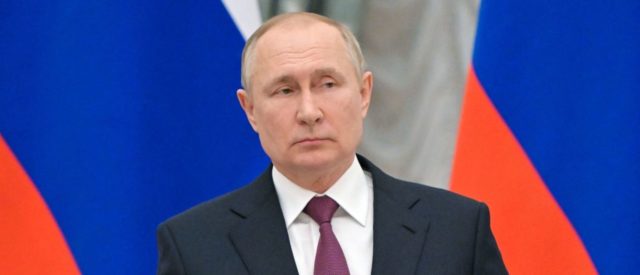The Ukrainian military has been making gains on the ground against Russian forces, prompting increasing pressure on Russian President Vladimir Putin at home. As supporters and arms providers to Ukraine, it behooves the United States to be very clear about the nature of Putin and his government.
He is ruthless, brutal and feared. We don’t know his limits, but he’s increasingly desperate for successes at home and is crushing opposition — arresting people, censoring news and seemingly killing his perceived enemies. There’s a long list of victims poisoned, pushed out of windows, blown up and shot and this is nothing compared to the ruin and victims he’s leaving in Ukraine. The United States needs to be clear about the nature of Putin and his government.
The names and number of Putin’s enemies who have died under sometimes strange and always brutal circumstances in the past two decades should be remembered.
Four prominent Putin critics have died since February. Igor Nosov, CEO of Russia’s Far East and Arctic Development Corporation died, reportedly, of a stroke. This month, Ivan Pechorin, 39, Putin’s hand-selected managing director of the Corporation, fell off his yacht. Lukoil chairman Ravil Manganov, 67, fell out of a sixth floor window in a Moscow hospital. Or was thrown out after being beaten. Dan Rapoport, a Latvian-born US citizen, fell out of the window of a luxury apartment building in Washington. [He was the second Putin critic to die in Washington, D.C. Mikhail Y. Lesin, 57, who helped create the Kremlin’s global English-language Russia Today television network, was found dead in a hotel in 2016.] Police found nothing suspicious.
All were opponents of the Ukraine war.
That’s this year.
Putin critic and lawmaker Denis Voronenkov (2017), Boris Nemtsov (2015), human rights lawyer Stanislav Markelov (2009), journalists Anastasiya Baburova (2009), Natalia Estemirova (2009), Anna Politkovskaya (2005), and Paul Klebnikov (2004), and politician Sergei Yushenkov (2003) were all shot.
Human Rights lawyer Sergei Magnitsky (2009) died in police custody after being beaten and denied treatment. Yevgeny Khamaganov (2017) editor-in-chief of Asia-Russia Daily died in unexplained circumstances that resulted in a coma. Putin critic Nikolai Andrushchenko (2018) of a severe beating — his third in a few months. He had told friends that he’d survived a previous attempt to poison him.
Semyon Korobeinikov (2008) — a clothing salesman — “lost his footing” on a balcony fell to his death. Only later was it understood that he had been a co-conspirator in a bank fraud case that might have required him to testify against a mob boss friend of Putin. Nicolai Gorokhov (2017), lawyer for Magnitsky’s family and a witness for the U.S. government in the investigation of Magnitsky’s death, fared a bit better. He fell 50 feet out a window “while installing a hot tub.” “The balcony fell off,” the Russian government said. After months in intensive care, Gorokhov said he was thrown out the window.
Bathrooms, clearly, are dangerous. Boris Berezovsky (2013), after a falling out with Putin, left for London. He was found dead in his bath in a locked bathroom with a noose around his neck. A British coroner did not determine the cause of death. More on the British in a bit. Poison? Yuri Shchekochikhin (2003) had what official reports called a “rare allergic reaction.” To “something.” His family believed he had previously been poisoned and this time it killed him.
Alexander Litvinenko (2006) drank radioactive tea in Britain. British coroners found nothing unusual in Alexander Perepilichny (2012) dropping dead on a jog. It might have been “bad sushi” they suggested. Later, an insurance company scientist uncovered traces of a toxic plant in his stomach
Vladimir Kara-Murza, leader of the Russian political opposition, directly accused the Kremlin of assassinating political enemies. In 2017, Kara-Murza was in a life-threatening coma with elevated levels of heavy metal in his blood; it was the second time he was poisoned. Partially recovered now and not in Russia, Kara-Murza called it retaliation for his work with American lawmakers on the Magnitsky Act.
Russia’s battle plans are, generally, grind up your own troops and grind up your enemy. It worked in Stalingrad, where Russian civilians and soldiers suffered endlessly to push back the Nazis. Their bravery was both awesome and awful. Hence Putin’s denunciation of Ukrainians as Nazis in an effort to justify the invasion of a neighboring independent country. After all, if they’re Nazis…
But Russia’s battle plans are the same regardless of enemy.
As many as one million Afghan civilians plus 100,000 mujahidin and Afghan troops died following the 1979 Russian invasion, along with 15,000+ Russian soldiers. Low-end figures suggest 30-40,000 civilians died in the Chechen wars, along with 3,000 Russian soldiers. The UN estimates more than 300,000 civilians killed in Syria (but the UN actually stopped counting after 300,000).
No Nazis.
The Ukraine war is not over – and may not be close. The litany of Putin’s victims — individuals and communities, soldiers and civilians, at home and abroad — should remain a touchstone for American political and military involvement with his victims.


